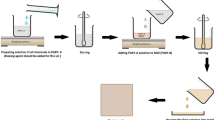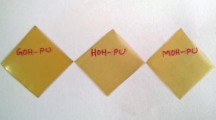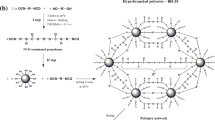Abstract
In this work, new polyurethane elastomers were prepared by chain-extension with varying molar ratios of curcumin or blends of the curcumin and different cross-linkers (glycerol 1,3-diglycerolate diacrylate, glycerin, castor oil, acrylate epoxidized soybean oil). All of the used cross-linkers derive from renewable resources. Structural studies performed by means of infrared spectroscopy confirmed that curcumin has been successfully included into the backbone of the polyurethane chains. Thermogravimetric analysis showed better thermal stability for samples with a low content of curcumin. The mechanical properties (such as tensile strength and elongation at break) of the polyurethanes with low curcumin content have proven to be very good and are similar to the values of the compared cross-linked polyurethanes.






Similar content being viewed by others
References
Poussard L, Mariage J, Grignard B, Detrembleur C, Jérôme C, Calberg C, Heinrichs B, De Winter J, Gerbaux P, Raquez J-M, Bonnaud L, Dubois P (2016) Non-isocyanate polyurethanes from carbonated soybean oil using monomeric or oligomeric diamines to achieve thermosets or thermoplastics. Macromolecules 49(6):2162–2171
Mahmood K, Noreen I, Riaz M, Zuber M, Salman M, Rehman S, Zia KM (2016) Synthesis and characterization of novel curcumin based polyurethanes varying diisocyanates structure. J Polym Res 23:233
Javni I, Bilic O, Bilic N, Petrovic ZS, Eastwood EA, Zhang F, Ilavsky J (2015) Thermoplastic polyurethanes with controlled morphology based on methylenediphenyldiisocyanate/isosorbide/butanediol hard segments. Polym Int 64(1):1607–1616
Chen J-H, Hu D-D, Li Y-D, Meng F, Zhu J, Zeng J-B (2014) Castor oil derived poly(urethane urea) networks with reprocessibility and enhanced mechanical properties. Polymer 143:79–86
Garrison TF, Kessler MR, Larock RC (2014) Effects of unsaturation and different ring- opening methods on the properties of vegetable oil-based polyurethane coatings. Polymer 55:1004–1011
Oprea S, Potolinca VO, Oprea V (2016) Synthesis and properties of new crosslinked polyurethane elastomers based on isosorbide. Eur Polym J 83:161–172
Zia F, Zia KM, Zuber M, Rehman S, Tabasum S, Sultan S (2016) Synthesis and characterization of chitosan/curcumin blends based polyurethanes. Int J Biol Macromol 92:1074–1081
Abdollahi MF, Zandi M, Shokrollahi P, Ehsani M (2015) Synthesis and characterization of curcumin segmented polyurethane with induced antiplatelet activity. J Polym Res 22:179
Shababdoust A, Ehsani M, Shokrollahi P, Zandi M (2018) Fabrication of curcumin-loaded electrospun nanofiberous polyurethanes with anti-bacterial activity. Prog Biomater 7:23–33
Mahmood K, Zia KM, Zuber M, Salman M, Anjum MN (2015) Recent developments in curcumin and curcumin based polymeric materials for biomedical applications: a review. Int J Biol Macromol 81:877–890
Mahmood K, Zia KM, Zuber M, Tabasum S, Rehman S, Zia F, Noreen A (2017) Morphological and thermal studies of chitin-curcumin blends derived polyurethanes. Int J Biol Macromol 105:1180–1191
Tang H, Murphy CJ, Zhang B, Shen Y, Van Kirk EA, Murdoch WJ, Radosz M (2010) Curcumin polymers as anticancer conjugates. Biomaterials 31:7139–7149
Mahmood K, Zia KM, Aftab W, Zuber M, Tabasum S, Noreen A, Zia F (2018) Synthesis and characterization of chitin/curcumin blended polyurethane elastomers. Int J Biol Macromol 113:150–158
Hu Y, Li Q, Hong W, Xing G, Jiang Q, Lv W (2014) Use of novel polyurethane microspheres in a curcumin delivery system. J Spectrosc. Article ID 926268
Matsumi N, Nakamura N, Aoi K (2008) Novel bio-based polyesters derived from curcumin as an inherent natural diol monomer. Polym J 40:400–401
Oprea S, Potolinca VO, Varganici C-D (2016) Synthesis and properties of polyurethane urea with pyridine-2,6-dicarboxamide moieties in their structure. RSC Adv 6:106904–106913
Nguyen MH, Yu H, Kiew TY, Hadinoto K (2015) Cost-effective alternative to nano- encapsulation: amorphous curcumin–chitosan nanoparticle complex exhibiting high payload and supersaturation generation. Eur J Pharm Biopharm 96:1–10
Souguir H, Salaun F, Douillet P, Vroman I, Chatterjee S (2013) Nanoencapsulation of curcumin in polyurethane and polyurea shells by an emulsion diffusion method. Chem Eng J 221:133–145
Oprea S, Potolinca VO, Oprea V (2018) Influence of the hydroquinone ether moieties and Bisphenol a glycerolate diacrylate on the UV stability behavior of new polyurethane materials. J Polym Res 25:79
Divakaran AV, Azad LB, Surwase SS, Arun Torris AT, Badiger MV (2016) Mechanically tunable curcumin incorporated polyurethane hydrogels as potential biomaterials. Chem Mater 28:2120–2130
Patra D, Khoury EE, Ahmadieh D, Darwish S, Tafech RM (2012) Effect of curcumin on liposome: curcumin as a molecular probe for monitoring interaction of ionic liquids with 1,2- dipalmitoyl-sn-glycero-3-phosphocholine liposome. Photochem Photobiol 88:317–327
Acknowledgments
We would like to thank Dr. Mariana Cristea for her help with DMA measurements.
Author information
Authors and Affiliations
Corresponding author
Ethics declarations
Conflict of interest
The authors declare that they have no conflict of interest.
Additional information
Publisher’s note
Springer Nature remains neutral with regard to jurisdictional claims in published maps and institutional affiliations.
Rights and permissions
About this article
Cite this article
Oprea, S., Potolinca, V.O. & Oprea, V. Synthesis and characterization of novel polyurethane elastomers that include curcumin with various cross-linked structures. J Polym Res 27, 60 (2020). https://doi.org/10.1007/s10965-020-2036-6
Received:
Accepted:
Published:
DOI: https://doi.org/10.1007/s10965-020-2036-6




